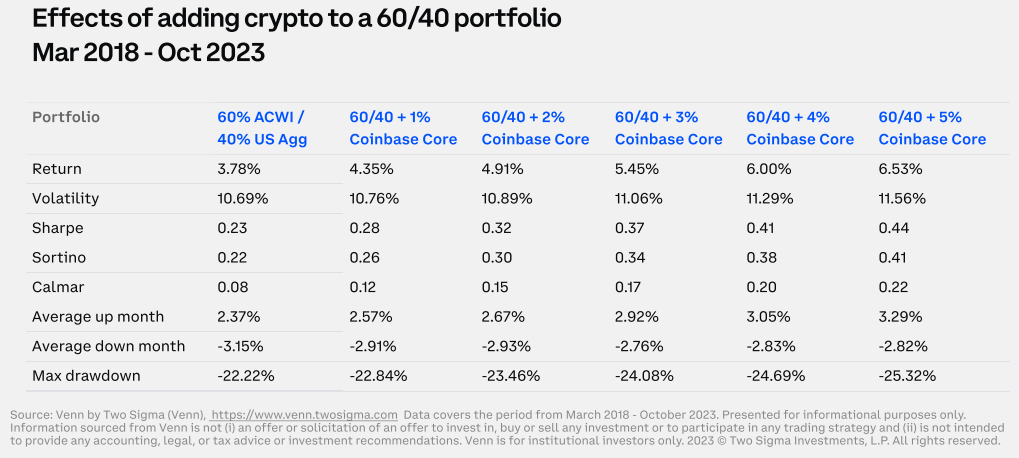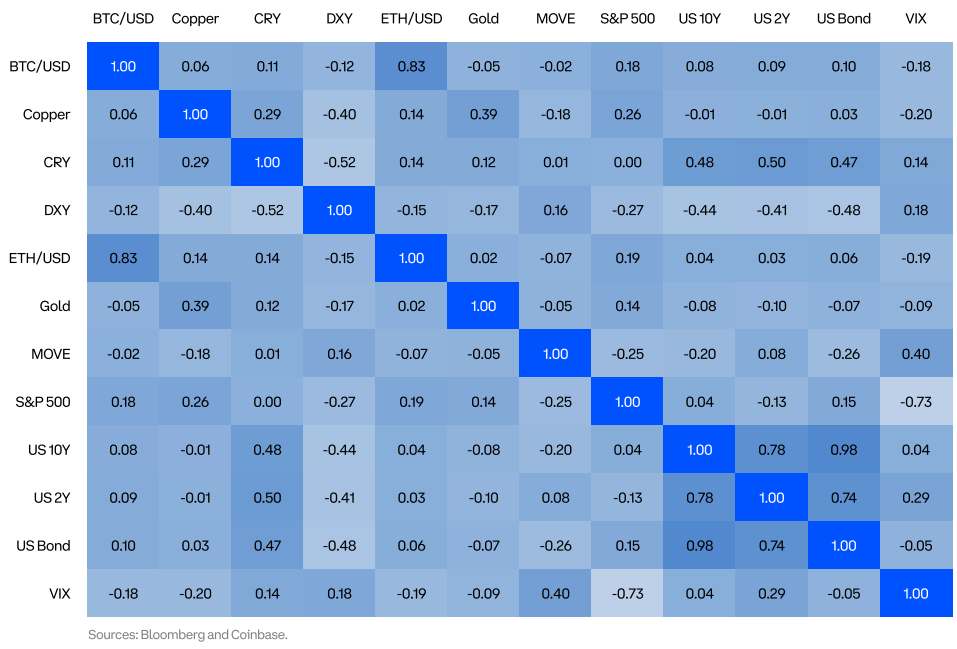How Crypto impacts portfolio performance and allocation
As the Q1 2024 Guide to Crypto Markets showed, crypto has already altered portfolio allocation strategies. Characterized by its decentralized nature and potential for high returns, crypto, offers a unique trading opportunity that challenges conventional paradigms.
2024 is the year in which Bitcoin and other digital assets can establish themselves as a go-to asset class for traditional finance. As the Q1 2024 Guide to Crypto Markets showed, crypto has already altered portfolio allocation strategies. Characterized by its decentralized nature and potential for high returns, crypto, offers a unique trading opportunity that challenges conventional paradigms.
In this article you'll learn how crypto can impact portfolio performance, diversification and risk.
Portfolio performance
As we will see, cryptocurrency can be a source of alpha for traditional portfolios. In the table shown below, we measure the effects of adding small allocations to the Coinbase Core Index (COINCORE) to a portfolio comprised of 60% MSCI ACWI and 40% US Agg, adjusting the equity and bond positions proportionally.

COINCORE is a market cap-weighted crypto index that is rebalanced quarterly, with an almost 94% combined allocation to Bitcoin (65.3%) and Ether (28.7%) among eight total constituents.
The analysis looks at the period from March 2018 – October 2023, which encompassed two major cycles of crypto price depreciation and appreciation. As seen in the table, adding COINCORE to the 60/40 portfolio increased both absolute and risk-adjusted returns. Please keep in mind that past performance is no indication of future performance, and this article is for educational purposes only and should not be considered investment advice.
Diversification and Risk Management
In 2023, Bitcoin reverted to low correlation with traditional asset classes like stocks and bonds, which makes it an attractive option for diversification. As can be seen from the matrix below, in 2023, Bitcoin showed a small correlation of 0.18 with the S&P 500 and 0.10 with US Bonds.

This data indicates that, traders can potentially reduce overall portfolio risk and improve risk-adjusted returns by including Bitcoin in their portfolio. This diversification benefit is particularly relevant in volatile market conditions, where Bitcoin's distinct market dynamics can offer a hedge against fluctuations in traditional markets.
Volatility Considerations
While Bitcoin presents opportunities for high returns, it is also known for its volatility. For both new and experienced traders, the substantial level of volatility represents a significant risk, but also the potential for large returns. With that in mind, keeping Bitcoin exposure in line with one's risk/return appetite is a crucial consideration during the portfolio allocation process.
Systematic momentum trading and similar strategies which aim to capitalize on the often trend-driven nature of crypto's price development are particularly likely to include digital assets in their portfolio.
Long-Term Perspective
For long-term traders, Bitcoin's historical price appreciation suggests it can be a valuable component of a growth-oriented portfolio. However, this requires a long-term perspective and a willingness to weather short-term price fluctuations, in order to capitalize on long-term trends.
Institutional Adoption
The recent approval of the BTC spot ETFs is evidence for the increasing interest and adoption of Bitcoin by institutional traders, which in turn lends credibility to its role in portfolio allocation. This trend is driven by the growing recognition of Bitcoin as a legitimate asset class and the development of financial products and services that facilitate Bitcoin trading for institutional traders. With that in mind, the digital asset space is still nascent and new traders should be careful not to assume the same level of sophistication and infrastructure robustness as with more traditional asset classes.
Regulatory Environment
The evolving regulatory landscape for cryptocurrencies also plays a crucial role in shaping Bitcoin's role in portfolio allocation. MiCA has created a clear regulatory framework for digital assets in Europe, while the US is still regulating through enforcement. Regulation across other markets typically falls in-between these two extremes. Before including Bitcoin or other digital assets in one's portfolio, it is important to fully understand the local regulatory environment.
Conclusion
Bitcoin's role in portfolio allocation represents a paradigm shift in trading strategies. Its unique characteristics offer opportunities for diversification, high returns, and risk management. However, traders must navigate its volatility, regulatory uncertainties, and evolving market dynamics. As the cryptocurrency market matures, Bitcoin's place in the trading portfolio will likely become more defined, offering new opportunities and challenges for modern traders.
Charts and data points were taken from the Q1 2024 Guide to Crypto Markets, which you can download for free here. To learn more about how to leverage Bitcoin's data to identify trends early, get in touch.

